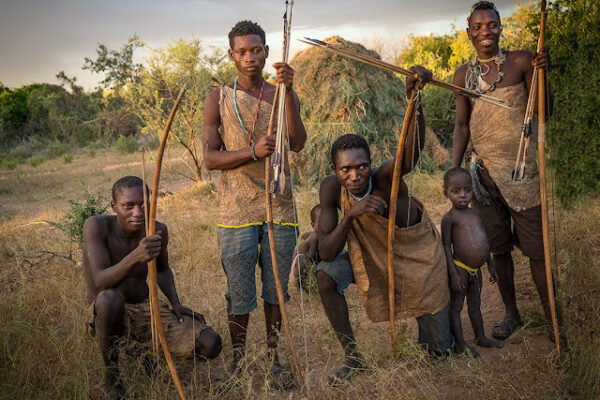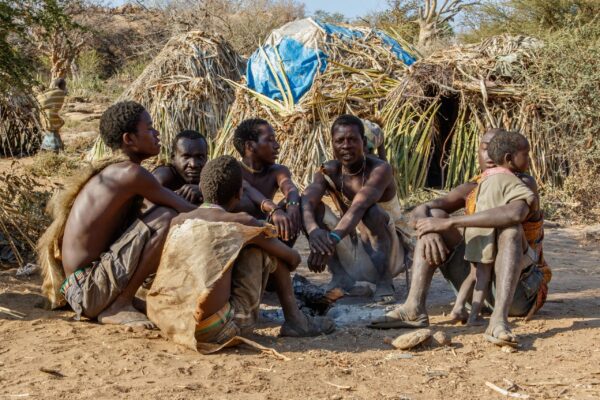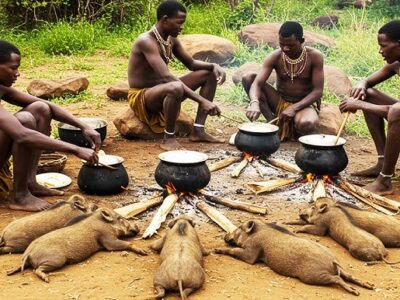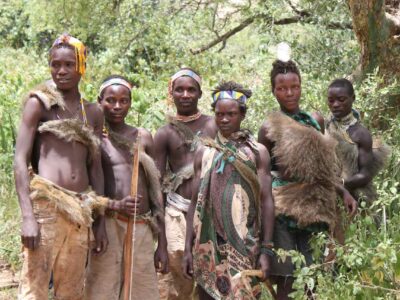The Hadzabe People: Facts, Location, Tribe, Food, and Marriage
The Hadzabe People
“Discover the Hadzabe people of Africa: facts, tribe, food, location, and marriage. Learn how the Hadzabe live. Explore the culture of the Hadzabe bushmen.”
The Hadzabe people of northern Tanzania are among the last remaining hunter-gatherer tribes in Africa, living a lifestyle that has changed very little for thousands of years. Residing near Lake Eyasi in the Great Rift Valley, the Hadzabe maintain a deep connection to nature, relying on bow-and-arrow hunting, foraging for wild fruits, and traditional knowledge of their environment. Their language, which includes distinctive click sounds, is unique and unrelated to any other in the region. Visiting the Hadzabe offers a rare glimpse into a truly ancient way of life that is both resilient and remarkably sustainable.
Despite facing modern pressures such as land encroachment and changing environmental conditions, the Hadzabe continue to preserve their cultural identity and independence. Unlike many other indigenous groups, they have resisted permanent settlements, agriculture, and formal schooling, preferring their nomadic traditions and communal lifestyle. Tourism has provided some economic support, but the Hadzabe remain cautious about external influences. Engaging with them offers travelers a respectful cultural exchange and a profound understanding of humanity’s earliest ways of living in harmony with the land.


Hadzabe Facts
The Hadzabe are one of Tanzania’s last true hunter‑gatherer societies, with an estimated population of just over 1,300 individuals. Their lineage stretches back thousands of years, retaining customs and techniques once common across Africa. The Hadzabe language features unique click consonants, bearing no close relation to neighboring tongues. They live in small, mobile camps of roughly 20–30 people, moving seasonally to follow food and water sources. Decision‑making is communal and egalitarian: elders guide but do not dictate. Their survival depends on intimate ecological knowledge, passed orally through stories and song. Despite external pressures, they maintain remarkable resilience and cultural integrity.
Hadzabe Location
The Hadzabe inhabit the forests and woodlands around Lake Eyasi in Tanzania’s Great Rift Valley, approximately 60 kilometers southwest of Arusha. Their territory stretches into the Karatu District’s baobab and acacia savannahs, where seasonal waterholes sustain wildlife and wild edibles. During the rainy season, many move into the nearby Yaeda Valley floodplains to exploit abundant marsh resources. Camps cluster near natural springs or dry riverbeds, ensuring access to both game and tubers. Their deep understanding of micro‑climates, knowing where honey nests form during droughts or where particular berries ripen, enables them to thrive in this rugged, semi‑arid landscape.
Hadzabe Tribe
As a tribe, the Hadzabe reject hereditary chieftainships, instead valuing an egalitarian social structure. Every adult participates in consensus‑based decisions regarding camp locations, resource use, and conflict resolution. Kin relationships are bilateral: children inherit connections from both parents’ lineages. Marriages are negotiated through gift exchanges rather than formal ceremonies, and polygyny occurs but is uncommon due to resource limits. Rituals center on seasonal cycles, collective hunts or honey‑harvesting festivals reinforce bonds and transfer ecological wisdom. Their spiritual beliefs intertwine with daily life, honoring ancestral spirits in sacred groves and interpreting animal behavior as omens or guidance.
Hadzabe Food
Diet revolves around meat, foraged plants, and honey, ensuring a balanced nutrient intake. Men track and hunt small to medium game, dik‑dik, bushpig, or warthog, using non‑poisoned arrows; success rates hover around 30 percent. Women and children gather over 200 known plant species: baobab fruit, wild cucumbers, tubers, and berries like tsama melon. Honey is a prized carbohydrate, extracted from hollow baobab trunks with smoke‑blown techniques. Water is sourced from natural springs or dug wells near dry riverbeds. Meals are communal affairs: freshly butchered meat is roasted over open fires, while gathered items are shared raw or pounded into porridge.
Hadzabe Marriage
Hadzabe marriage practices emphasize flexibility and mutual consent. Courtship begins with gift‑giving; women receive beads, metal goods, or livestock tokens from suitors. Once both families agree, they formalize the union without elaborate ceremonies: cohabitation suffices. Polygyny exists but remains rare, as supporting multiple wives strains food resources. Divorce is possible if either partner feels incompatible, returning gifts, and rejoining their natal camp. Children belong to the union communally, raised by the broader camp rather than solely by biological parents. Marital alliances also serve social cohesion, forging ties between separate camps and facilitating cooperative hunts and resource sharing.
Travel Advice From JimJam Safaris
We cater to all ages, budgets, interests, and fitness levels. Our team can assist with queries about Hadzabe tours, Accommodations, bookings, and Affordable Luxury destinations. We will respond to your Inquiry as soon as possible. Our team of friendly and service-minded Safari Consultants is available to assist you in making a private, personalized, tailor-made Safari Itinerary and to answer all questions you might have. Are you dreaming of the Wildebeest Migration? Gorilla Trekking in Africa? Honeymoon In Africa or Africa’s Big 5 Experiences? Start planning your affordable luxury African tours with the Affordable Luxury African Safari Company (JimJam Safaris & Tours Africa). We tailor-make African Safaris for First Timers, 7-Day African Safari Tours, African Bush Safaris, and Beach Vacations.

